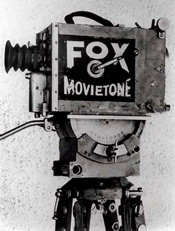Everyone loves a good movie, whether it’s viewed in a cinema, on the telly or on a laptop. For ages now, movies have been available to buy and own on VHS video tape, DVD and Blu-ray. People looking to rent a movie don’t go to rental stores anymore, because mostly they no longer exist. Online movie rental has taken over; streaming services like Amazon Instant and Netflix have superseded video rental stores like Blockbuster.
DVD and Blu-ray. People looking to rent a movie don’t go to rental stores anymore, because mostly they no longer exist. Online movie rental has taken over; streaming services like Amazon Instant and Netflix have superseded video rental stores like Blockbuster.
Modern movies are fantastically realistic and engaging, but what makes them possible?
The Illusion of Motion
The motion picture camera was invented in the 1890s, and although that seems a long time ago, technology moves much faster than evolution. Then and now, the movie camera works by recording a series of still pictures (frames) in rapid succession, which, when played back, create the illusion of  movement. Movie cameras have become more advanced over 130 years, but the human body remains the same.
movement. Movie cameras have become more advanced over 130 years, but the human body remains the same.
There are two optical phenomena in humans that enable movie cameras to work. Persistence of vision is often described as the main enabler for the illusion of motion in movies, but in truth this is slightly misleading. If a bright light is flashed before you (e.g. a torch), you’ll note it looks like a continuous streak of light. For a fraction of a second, the brain freezes the i mage of the light at every point along its path. When watching a movie, this same phenomenon prevents you from seeing the black spaces between each frame, but something else creates the feeling of movement.
mage of the light at every point along its path. When watching a movie, this same phenomenon prevents you from seeing the black spaces between each frame, but something else creates the feeling of movement.
Phi phenomenon occurs when two slightly differing images are presented in quick succession to create the illusion of motion. A crude example of this is seen when you draw slightly different pictures on the corner of every page in a book. If you then quickly flip through the pages, the image appears to come alive and move. In principle, a movie camera works the same way. Early experiments showed that images had to be played back with a particular frequency for the effect to work optimally, that frequency being 60 milliseconds (about 16 frames per second).
Early Moviemaking
Because film was expensive in the early days of movies, filmmakers saved money by shooting at slow frame rates down to 16 fps. Nowadays, the standard frame rate for movies is 24 fps . Interestingly, this is not a high enough frame rate to reduce flickering in video games, but in a movie the flickering is ironed out by the natural motion blur that occurs in subjects when recording each frame.
. Interestingly, this is not a high enough frame rate to reduce flickering in video games, but in a movie the flickering is ironed out by the natural motion blur that occurs in subjects when recording each frame.
The 24 frames-per-second motion picture standard that still exists today came about with the addition of sound. Fluctuating frame rates during hand-cranked silent movie playback were visually tolerable to an audience, but wavering sound was more irksome. To synchronize picture and sound at a steady rate, it was decided to run movies at a constant 24 fps.
